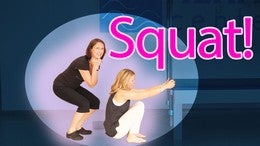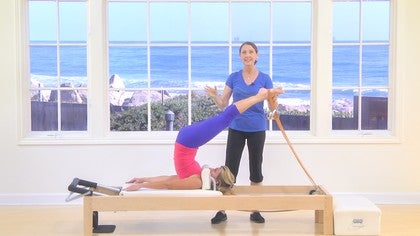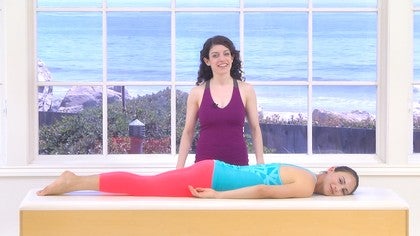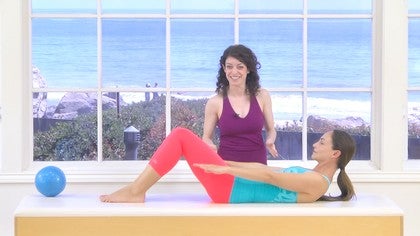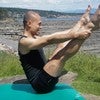Description
About This Video
Transcript
Read Full Transcript
Hi everyone. I'm Amy Taylor Alpers from the Palati Center in Boulder. Maybe some of you guys have watched my podcast on squatting. You know, I'm pretty committed to the idea and the reality is that Joe's book, you know Joe Plot, his book returned to life's pretty much about basically returning the body back to what it's really supposed to be able to do. And squatting is a basic basic function. A lot of us can't really do it anymore or we struggle with it or we have some fear around it. Maybe we even have some pain, low back, hip, knee, ankle, all that kind of stuff. But really ultimately the human body should be able to squat.
And when you start looking at plot you realize it's basically a squatting system. So it's really designed to free your body back up again so that you have that capability. You have all the range, you have all the strength and you have very, very healthy joints that can handle all of that. Okay. So we start kind of slowly, you know, even footwork on the mat are on the chair. You're basically starting to get that nice ankle, knee, hip range happening, right? We're slowly working our way. And then maybe we start doing some certain leg circles and frog, right? And then eventually we can even go into short spine.
So we're gonna actually start in short spine and then you can even look backwards at something like leg circles and frog and see what you might've been able to do there for your own body a little bit better so that when you get to short spine, it feels even nicer. All right? So we are looking at Nice Freedom, nice freedom, nice freedom, but also nice freedom right here. Okay. So we would love to see that that sacrum and lumbar spine are very, very flexible and, and move with freedom and move with almost like a wave action up and down your spine. And it should just be the way a spine should be. Okay, so we're gonna try and get that out of shorts by to start. So headrest is down more on two springs. All right? On this piece of equipment, you're going to exactly thread the loop of the leather through the handle if you can, because you have all this nice flexibility and strength we're looking for. You actually bend your knees into your chest. You lift those hips to put your feet in your straps, right?
You keep those knees on the chest, pull the belly deep to the spine, rule your spine down, and then the thighs stay on the chest and you bend at the deep muscles of the hamstrings as your abdominals. Stay deep to your spine. Okay, so we're basically starting in a squat. Do you see this? Right? So I always will just take a moment there. If I feel there's any tension or resistance or something, relax the knees a little bit. That's the way, right? So that we feel very mushy like that. Yeah. And so the hips are released, the knees are released, the ankles are released.
But especially you see that lumbar spine has some freedom in it and it's already in a little bit of a curl, but the abdominals are very, very deep. Right? So you're not tucked, you're not let go here. This is deep, but you are still in a little bit of a curl. And then that allows, which would be the first movement as you stood up from a squat, that actually your hip extenders versus just your quads, right? Take some of that load, which protects the back. So you step into your strap from this deep squat, connect those hips, right? That would be your big inhale. Take a nice exhale. You just try to keep this length, lift the whole thing up to the feet, little less ankles, the little more hips for and say no hanging baskets. Okay, so now we're up as high as we could be and you're only gonna go this far. You should be on your upper thoracic spine, not on your neck.
But then you bend those knees again all the way to your ears. Hopefully this looks familiar, this position. Relax a little bit in here. Big Inhale. And then you exhale, you roll down and as you roll, you keep those thighs on your chest. Dominoes go down the spine. One vertebrata 10 you open your low back, your sacrum, your tail.
So you have this sense of your low belly way over here and your knees way over here in opposition, right? That's what kind of frees you to lengthen your low back, right? And then again, excuse me, you use those big hamstrings to bend your knees and your spine basically stays in a very similar shape. It doesn't so much go down to the mat until you are at those hips. Step onto your strap and then your hips continue and you go up a little less ankle moral, hip lift, right?
Free knees, free hips, pre spine, big inhale. And then you exhale and again, you're keeping these thighs on the chest and we're going to see that in your tree, in your front splits, lots of exercises, your monkey, right? And you can take even a moment here and help get a little more length by kind of stretching the hamstring away from the foot a little bit to help her free her low back, even more. Pull the abdominals in even deeper in that oppositional energy and then use these hamstrings to come in really, really small this way. All right, so let's say one more. Inhale, exhale, lift the hips to the feet.
Another big inhale, the knees soften the back. Go ahead and bend the back releases and maybe curls a little bit more than a deep exhale. Thighs stay on the chest. It's almost like they're trying to stay over here so the belly can go into the lumbar and open this up, right? And then it goes as low as it can, but it's still in opposition to this. So it's not like she just flattened her back and tried to get her sacrum on the map.
Over time it may release and get freer and some people may already be lower, but it's not your goal so much. It's just relative to you getting a little more range in there. And then Nice, strong cause here you could crank on your back a little bit if you weren't careful. Belly to spine and then use those hamstrings really powerfully and yeah, and see if you can come back to this squat position instead of what we like to tend to do is kind of push past it a little bit and then you're stuck actually kinda tightening your back, right? And holding the spring out there with your quads instead of releasing and allowing the spring to do this yummy thing. Relax your knees a little bit more, put your heels on your butt right and letting the spring do this thing where it's actually pushing you this way and you're enjoying that, right instead of pushing it away from yourself so much. All right, so think of how many times in Palladio's you're in this position, right? Tower, we're going to do stomach massage next rolling like a ball stomach series.
So many exercises and we often just kind of are out here sort of arbitrarily actually tightening things and are at the very least not getting the deep yummy, deep massage, stretching and opening of tight stuff. That is the goal so that you could come up and then just squat down and come back up again. No problem. Okay, so sorry for the next one we're going to go into coordination. Okay, another perfect example. Go ahead and hold your legs up. Uh, maybe an exercise where we don't always bend as much as we could. So you actually use that final position from your short spine, right? So you're way up here. I mean that plot is rules.
It's usually here's between knees, right, knees up to ears, that kind of thing. And that means you have to lift this. You're trying to get your thighs on your chest and you're trying to loosen that lumbar spine a little bit, right? And then you go low. You if you can, you go hip extension to open the hip, open, close. And then on your exhale again, you hip extend. So that curls your pelvis and tail. And You bring those knees all the way to your ears, so you go inhale, big inhale, open, close. Then you exhale, pull it all the way in like that, and then your elbows one more and inhale and exhale all the way in.
Exactly. And rest very, very nice. So it's less kind of knees and feet and even hip joints and more hip extension through the back of dominance through the front and then a nice soft, simple regimes. The way the lumbar spine should bet, right? No strain, no stress, no weight in it. You're not putting weight in it. You're just allowing it to bend and unbend as those knees come in and those knees go out, just like when you squat and stand. Okay, now we're going to look at stomach massage. Okay, so a lot of resistance to this exercise for a lot of people, especially to the main goal kind of, and that's it.
You sit as close to front as possible. We don't like that, but if you sit too far back, right, then you're going to be doing kind of what we were just talking about in the short spine, which is where you're going to be basically doing a leg exercise, right? And we want this to come all the way in and curl the spine, squish your guts. Stomach massage, right? School should guts and open and free the back a little bit. All right, so we're in it again. Here's that nice to ears. If you can't, so you're in a round spine, you're sitting backwards in your pelvis, but there's, again, there's no down, still up, but it is curled so that when she pushes, she goes hip extension, no hyperextension. So yes, lower left, right? And then exhale, curl the hips and squash yourself together. So we're in the same position again, right? Inhale, Allez big open back. Exhale deep. Squeeze the air out and no and hail and exhale and inhale and exhale. Good. Now look at what happens if Christy just moves back two inches.
So she's there right now. And only now does she have to reach way forward for the front of the Mat, which makes her want to do this to her shoulders. Right? But when she pushes, she has a lot of room and choice so she can kind of lean forward on her legs a little bit. Right? And we're not getting the same kind of suspension out of equipment kind of. Right.
So she can just kind of be there and moving this springs around and people even sit farther back and then you get nothing except quads. Right. And if she were to come really far forward, really crazy far, you'll actually see that what happens is then the springs actually have an opportunity to help her squad. Right? Susie? He's in an almost un-doable position. She has to go right away. But then the springs help her come home and squash everything with her exhale.
Right? So that, that next inhale is from way deep. So Ramana would even say eventually, like you had to sit off the front of the carrots, just try it and be surprised, actually. Right. You know, it's especially nice for reaching. So if you come home, let's do the reaching, right. So she goes out and in and comes all the way home. Right? And when she comes home, it's going to ha you have to curl. And we want that because then when she pushes, she pushes hips, belly. Right? And exhale all the way in like that. Exactly.
And exhale all the way in. Good. Now if you try just putting your hips right on the front edge of the carriage, you'll actually be surprised. It can feel really, really nice. Yeah, just like literally just a little bit off and then you're like, it can't be right. But you'd be surprised. It actually feels quite good and you push out and then you come all the way home and it brings you home. It brings you home and brings you home. And it makes you have to release and curl. Grab your abs, and then push from your hips.
Right? So it's nice on the knees. It helps you breathe a little bit better. You're also don't move around so much. Be surprised. Just try it. It's not, it actually does feel good. I know. It can look like, yeah, you can look like you're a little bit over smushed, but you're really not inside. You feel like this deep massage and this kind of deep organization that only comes from letting the equipment help you in a versus sort of riding the surface of it a lot, which does happen, right? So hopefully we're getting that idea so that when you squat, you're going to come all the way down. You want to come all the way down.
This curls under ankles, knees, hips are very flexed and then you stand right back up again and you're on your feet. Our world, of course is sit in a chair, which all he has collapsed in it and then stand up from not being on your feet and try to get your body over your feet. It doesn't work very well. So this is definitely take your whole body into the smallest coil it can and then let it open and close and let that spring help you release that last couple of inches. So, so that you get more supple there versus kind of build a wall right there. So now let's look at tree. All right? So again, tree can be a bit of an of an exercise where we kind of sit up straight and move our knee around in space. Or it could be stomach massage, it could be a squat. All right, so she's going to have a seat put under your strap. Great. All right, so now she comes into holding one knee. Now a lot of times people just kind of sit up, right?
And then hold this knee out and then we go like straighten and bend. It's this and the exercise, right? So really what it could be should be, is a little more of the curl here. The spine is rounded. You can even curl here and then again, you're going to get this elbow way under there, right? So you're in this small position again, right? You still have lift, you're not hanging, but you are round. And again, the thigh is actually quite vertical, not the spine. The spinus c shaped. The thigh is vertical, so that when instead of necessarily just doing a knee thing, maybe even relax your ankle a little bit, just a little bird on a perch kind of feeling.
So you have a foot that's active but not two ankles. [inaudible] and then hips narrow and the leg grows up out of the hip, right? And it comes to the tree and down. So it comes to this vertical lifted leg that's coming out of the rounded spine. The flexible spine. You're as old as your spine is flexible, right? So we're not trying to hold the back flat. You can as you get up, and this is so much like monkey right here you are. She never hands up here, but it'd be the same. You can still hold that, right?
And then you can lift your spine up, still keeping your hips in your curl. So you're still trying to find your left, right? And then you could flex and point, walk your way up, right? You still find this, you still find this, you try to get your head all the way. So again, we're always creating these really tiny positions. If you can. Now of course Christie's very flexible. You do what you can, right? And this narrowness right here, this power from the hips is so, so strong that your back is very, very safe. Okay, so this has been that. Let's see your other leg just so that you get to do both legs and they can see it again. So in other words, you're not sitting flat through your spine.
You have a curl but you're not hanging in your curl. You have a tremendous suspension lift. But the hips are just like in stomach massage this and or in our shorts. Mine too, right? This is nice and lifted, but she doesn't come forward and sit tall. So sit up for a second. She's not here where she's basically in hip flection and then the only muscles that are working our back trying to hold me and then quad a knee grinding, right? So we're curled, this is very lifted, just like short spine and this is very lifted, just like shorts. Fine.
And then he says if the tree just grew out of the plant base in your pelvis, right? Like your roots are in your pelvis and you've got this deep curl. Beautiful Zackly. Yes, right. The knees very. If people's knees are making noise, it's probably because you're sitting up too hard and then the knee is trapped inside that. So you get to curl under just again, you're not hanging, always lifting just like that. Right. And then you climb up and you get even taller. Right.
All of this is lifted and all of this is lifted. Right. And then bend your knee. Yeah. Yeah. So it's opening everything rather than sort of teaching you some kind of arbitrary choreography. Exactly. Exactly. Okay, good. So let's take that into knee stretches. Right? Again, sometimes on these stretches we just limit our range a little bit and then it doesn't get as deep as it could to free the body up so it can spot. Okay. So she's going to kneel, we'll do knees down first.
And what I like to do is just have people sit pretty far back, ears between the elbows. Right? So that, and then just, we're not going to stretch this. So maybe just, I say sometimes like Swan your back out just a little bit, right? So that's relaxed. But we are connected like we were in tree and we have a beautiful abdominal lift that's different from overstretching. Your back are making a shape with your back, right? So we have power hips and then we have a beautiful scoop, but the back of a little more rest.
And that's true whether you're in stomach massage, shorts, spine or knee stretches, right? So you're not overstretching your narrowing and scooping, curling, okay. The knees are free so you can soften the knees and flex them a little bit more and sit lower. Right? They're so free that in a second they're going to levitate because we're standing on our foot and our hips and our hands. The knee really has no weight in it.
So that basically what happens is you push out and then you come back in and the whole spine curls. So you see that spine go out and you see that spine come under and it's free to do it right. Little less tension here. A little more work here. Right? And maybe you could even sit back farther. Yeah, get the headway down and then think back here. So you push back and then you curl all the way under and that's that light.
Nice feeling of stemming. Massage comes all the way in. The back is free. It's going for a ride. The knees are free, they are going for a ride. It's the abdominals, the standing on the feet in the hands and feeling really suspended between the two such that when it's time to lift those knees they can lift. Yeah. All right, so that's the feeling we want to actually see that. That's fine. You know it has a like a wavelike quality. It just open and close and open and close. So if you were doing, and you can rest for a second, if you were doing what work on the mat or double leg stretch on the mat, every time you would come in you go full knee, hip flection.
But then you also go lumbar fluxion and then back out again. So that spine is always getting a beautiful massage. And there's this really literally, I'm sure if we were looking at the fluids in the spine and the energy, electricity in the spine, it really is waving back and forth and that the spine becomes this amazing kind of channel, right, for your energy rather than something that gets very stuck. So another huge piece of [inaudible] is this amazing, flexible spine, not hyper mobile and not stressed, just flexible, just able to bend the way it would if you squatted and you stood. Okay, so simple, simple, natural, normal, healthy, returning the body back. Okay, so let's show front splits. Okay, so she's going to come on up.
It's going to put the ball on one foot in the middle of the foot bar, heel to the other one back. She'll be in a little turnout in the back. And then here it is again. A lot of people stay very high on this exercise and work their legs. But in an ideal world, you're going to get in nice and low. You're going to get that chest on your thigh. You're going to still, this is tree, right? She's got this nice narrowness through here.
And then as if she had that leg and she had her little curl in her spine all the way from here, she's going to straighten that leg. And basically it's the same as short spying too and come back in. Now we're going to keep the hips low the whole time. Go thumbs with fingers and maybe bend your elbows just a little bit, right? Stand here and then push both feet out simultaneously and stay close to that leg and see if you can get even lower here. Exactly.
And when you come in you stay low in that back hip. So you get this beautiful opening. You're not hanging, you're standing on your foot. Right? But you are trying to open this and the narrow, keep this core, this hamstring like we talked about in short spine right there on your chest. And then the hamstring opens, but you're standing on your feet and then you'd come back in and you stay nice and low. Go ahead. And now again, Chris, he's very flexible and it might not look like this on you, but you want to try to get into this line where you're straight out to your foot and then straight out to the other foot, right? And then come back in really low like this in these oppositional energies.
And that's how all of this stuff really opens up, right? Do you want to do your other leg real quick? Okay. Cause once you've done it on one, like you have to do it on the other. So you know you may start higher, but try to get lower with your pelvis, right? So your pelvis is trying to get low again.
There's a tendency to want to hang in this knee. You've got to still be standing on this foot and standing on this foot so that you're splitting out from your feet and not hanging in your knees, but you're working on your square pelvis from your tree. You're working on trying to keep that thigh on your chest and then coming back in deep in the hips, standing on the feet, right? So that you're getting all this incredibly deep range around your hip. The back is fine, it's very supported, and then you come back in. Staying low, staying low, staying low, staying low.
Good. Come up and turn around really quickly. Let's just show one Russian squad and the other way, right? So hands go on your shoulder blocks. One foot can either, you could start, typically you start back here. Yeah. So put one foot back here and then the other foot goes to the shoulder block and that's a little trickier. If you have more flexible knees, walk your toe forward about halfway up. Good. Now again, you're going to bend down pretty low. You've got to find this footing. So maybe I get a little lower. But you want these hips nice and low.
Most people are going to try to stay hot. Now you're not hanging. You're standing on this foot. Exactly. No hanging. But you are low so that when you start this big, deep stretch, yes, when you come back in, you stay low like that and you've still working this amazing hip range. It's very powerful. Spine is free and floaty. No biggie. The knee is fine cause you're standing on your foot.
You're not hanging on your knee. Exactly. So get deeper than you think because that's how you're going to open those hips up and honestly go ahead and come in and you can put this foot down your, you know, that's one of our biggest issues in the world. Today's hip fracture and hip osteopetrosis, etc. So to get these exercises into the hip, to make the hip flexible, to get a lot of fluids, a lot of that deep internal shower into the hip as opposed to keeping it out here somewhere a little bit at bay. Right? So we're going to finish showing you the Russian squat.
Now I would say don't try this at home alone, but if you've got a workout partner and you want to partner each other, do, but you'll see it's kind of the ultimate place we're headed, right? It's not just a bunch of arbitrary exercises. It's really intentionally heading you to this spot. Okay? So she's got her handles, she's going to start in a squat. You want to start a good four inches in front of the back edge of the carriage, but not too much farther than that. So you have some room to play with, but also not so far back that you could conceivably tip the carriage.
So you always want to stay just a little bit in front of that edge. You're starting in your squat, right? You have to build to that if you don't have it, but you have your hip power. Your spine is a little rounded at this point. Deep knees, deep ankles. Okay. It's like water skiing a little bit.
You push those feet down and you press that care down in front of you. See where I'm holding her now? I'm not, I'm just hands here. I'm not holding her because she has to move. And then you start your squad again and you see the spine goes down and then at the very end it curls. And that's what we're doing in every exercise so that we start hips, abdominals, and then back down again.
And then the curl at the end. Right? One more time. Big Inhale, and then exhale. And I'm just giving her guidance and I'm staying here very close to her just in case. And then when she's down at the bottom, she can kind of lean forward, grab her shoulder blocks and hook her handles up. All right? That was on two springs case. You're going to try it that it's very, you know, even advanced students, you have to be careful getting it all cavalier with that one cause all of a sudden bang balance. Oh my gosh. It's a really a controlled Ajai exercise. You could go that way. I know people who have, I don't want to underestimate the safety issue on that one, but I just wanted you to see if we get her footwork on, we start freeing that lumbar. We start freeing the hips, freeing the knees, standing in the strength of here and here that will protect this, right? Allow us to start feeling like it is a flexible thing. It should be a flexible thing and we would love it to return back to being flexible so that it can be as healthy as it possibly can. Okay, so honor your commitment. Release those knees, release those hips, release those lumbars mines and return people back to life.
The Successful Beginner - Playlist 7: Movement Breakdowns
Comments
I find very informative class for me .
I cannot stay with my Heel on the Floor when Im squatting down.
So I don't russian squat on the ref
Where I can do similar work ?
Monica
I grew up squatting all the way down on flat heels while doing everyday tasks so it's quite refreshing to see a Pilates tutorial on it.
Loving this site :)
You need to be a subscriber to post a comment.
Please Log In or Create an Account to start your free trial.
